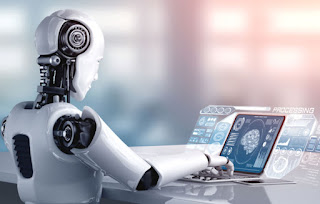The Top 5 Upcoming Technologies That Will Change The World
The Top 5 Upcoming Technologies That Will Change The World
In today's rapidly evolving world,
technology plays a pivotal role in shaping our lives and transforming
industries. As we step into a new era, where innovation and advancements are at
the forefront, it's crucial to stay informed about the upcoming technologies
that will have a profound impact on our future. In this article, we will
explore the top 5 upcoming technologies that are poised to change the world as
we know it.
1. Quantum Computing: Unlocking Unprecedented Power
Quantum
computing is set to revolutionize the way we
process information. Unlike traditional computers that use bits to represent
information as either 0 or 1, quantum computers use quantum bits or qubits,
which can exist in multiple states simultaneously. This incredible property
enables quantum computers to perform complex calculations at an unprecedented
speed, making them ideal for solving problems that are currently infeasible for
classical computers.
One of the most exciting aspects of quantum
computing is its potential to transform fields such as drug discovery,
optimization, cryptography, and weather forecasting. For example,
pharmaceutical companies can utilize quantum computing to accelerate the
process of drug development by simulating molecular interactions and predicting
their efficacy. Similarly, optimization problems, such as route optimization
and resource allocation, can be solved efficiently using quantum algorithms.
While quantum computing is still in its
early stages, major tech companies like IBM, Google, and Microsoft are actively
investing in its development. As the technology matures, we can expect quantum
computers to become more accessible, opening up new possibilities and
transforming various industries.
2. Artificial Intelligence: The Rise of Adaptive AI
Artificial
Intelligence (AI) has been a game-changer in recent
years, and its advancements continue to push boundaries. In 2023 and beyond, we
will witness the rise of Adaptive AI,
a technology that constantly learns and improves its understanding of the
world. With Adaptive AI, machines can tackle even the most complex tasks,
enhancing scalability, performance, and data security.
One of the areas where Adaptive AI is
already making a significant impact is in customer experiences. Chatbots
powered by Adaptive AI are revolutionizing industries such as manufacturing,
finance, education, healthcare, and administration. These intelligent chatbots
provide personalized and real-time assistance, improving overall business
performance and customer satisfaction.
Furthermore, Adaptive AI is set to drive
advancements in various sectors, including autonomous vehicles, robotics, and
healthcare. For instance, self-driving cars equipped with Adaptive AI can adapt
to changing road conditions and make split-second decisions to ensure safe and
efficient transportation. In healthcare, Adaptive AI can assist in diagnosing
diseases, analyzing medical images, and even predicting patient outcomes.
As technology continues to evolve, Adaptive
AI will play a crucial role in shaping our future, improving efficiency, and
enabling new possibilities across industries.
3. Additive Manufacturing: Transforming Production
Processes
Additive
Manufacturing, also known as 3D printing, is poised
to transform the way we design and produce objects. Unlike traditional
manufacturing methods that involve subtracting material from a larger piece,
additive manufacturing builds objects layer by layer, allowing for complex
shapes and geometries that were previously impossible to achieve.
One of the most exciting applications of
additive manufacturing is in the field of bioprinting, where researchers are
working towards printing functional human organs. This breakthrough technology
has the potential to revolutionize organ transplantation, addressing the global
shortage of donor organs and saving countless lives.
In addition to bioprinting, additive
manufacturing offers benefits across various industries. For example, in the
construction sector, 3D-printed houses can be built at a fraction of the cost
and time compared to traditional methods. Manufacturers can also leverage
additive manufacturing to produce custom parts on-demand, reducing inventory
costs and enabling rapid prototyping.
With advancements in materials and printing
techniques, additive manufacturing will continue to disrupt traditional
production processes, offering greater flexibility, customization, and
sustainability.
4. Industrial Internet of Things: Enabling Connectivity
and Visibility
The Industrial
Internet of Things (IIoT) is a network of connected devices and sensors
that collect and exchange data to optimize industrial processes. By integrating
physical and digital resources, IIoT enables real-time monitoring, automation,
and improved supply chain visibility.
Smart manufacturing, a key component of
IIoT, allows for agile and responsive production processes. Manufacturers can
leverage data analytics and machine learning algorithms to optimize production,
reduce downtime, and improve overall efficiency. For example, predictive
maintenance powered by IIoT can detect potential equipment failures before they
occur, enabling proactive maintenance and minimizing disruptions.
Supply chain visibility is another crucial
aspect of IIoT. By connecting various stakeholders, including suppliers,
manufacturers, and distributors, IIoT provides real-time insights into
inventory levels, demand fluctuations, and logistics. This enhanced visibility
enables organizations to make data-driven decisions, optimize inventory
management, and improve customer satisfaction.
While IIoT offers numerous advantages, it
also presents cybersecurity challenges. Protecting sensitive data and ensuring
the integrity of connected devices is paramount to maintain a secure and
resilient industrial ecosystem. As the adoption of IIoT grows, addressing these
security concerns will be crucial for its successful implementation.
5. Low-Cost Sensors and Prognostics: Predictive Maintenance
Made Affordable
In the world of manufacturing, proactive
maintenance is key to maximizing operational efficiency and minimizing
downtime. Low-cost sensors and
prognostics are emerging technologies that enable predictive maintenance by
continuously monitoring the health of machines and systems.
Traditionally, predictive maintenance has
been costly and complex, requiring specialized equipment and expertise.
However, advancements in optical equipment and computational capabilities have
made low-cost sensors and prognostics more accessible. Optical equipment can
now detect tiny details that may indicate potential issues in a system, while
affordable computational capabilities enable efficient data analysis and
predictive modeling.
The implementation of low-cost sensors and
prognostics is particularly impactful in industries where small inefficiencies
can have significant financial consequences, such as chemical and refinery
companies. By detecting potential maintenance needs before they lead to costly
breakdowns or disruptions, companies can save substantial amounts of money and
improve their bottom line.
Furthermore, the application of low-cost
sensors and prognostics extends beyond maintenance. These technologies can also
be utilized in optimizing energy consumption, enhancing product quality, and
improving overall operational efficiency.
Conclusion: Embracing the Future of Technology
As we look ahead to the future, it's clear
that technology will continue to shape our lives and transform industries.
Quantum computing, Adaptive AI, additive manufacturing, the Industrial Internet
of Things, and low-cost sensors and prognostics are just a few examples of the
upcoming technologies that will have a profound impact on our world.
Embracing these technologies requires a
proactive mindset and a willingness to adapt to the changing landscape.
Organizations that stay ahead of the curve and leverage these advancements will
gain a competitive edge, drive innovation, and unlock new opportunities.







Comments
Post a Comment